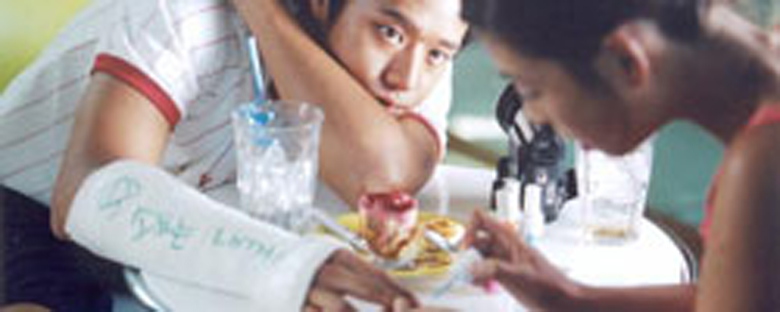It’s not news to anyone cognizant of contemporary international cinema that recent films coming out of South Korea have become rather trendy. In the last five years especially, Korean films have steadily attained as high a profile as those of the country’s close neighbors. In the U.S., arthouse films, martial arts epics, thrillers, and horror movies compete admirably with those of Hong Kong and Japan, forming an imaginary niche-cinema archipelago that promises the extremities of Asia in the face of the purportedly more tepid occidental varieties. The representatives of South Korea at international film festivals seem to increase exponentially each year: six Korean films were shown in the first forty-two years of the New York Film Festival, while last year’s festival featured three. Certainly this newfound trendiness now makes Korean films valuable fodder for Hollywood’s indefatigable remake-mill. This summer’s Bullock-Reeves weepie, The Lake House, may be the first of this trend, being an anglicized reading of the 2000 Korean romance, Il Mare (other remake prospects include Oldboy and, more oddly, the rather localized JSA).
Whatever the cultural source of this recent fascination with the films of South Korea (a recent awakening from historical amnesia? the enchanting mysteries of the Orient? the enduring conundrum of the nation’s northern counterpart?), the political causes are more obvious. With the relaxation of censorship laws in the late 1980s, the Korean Film Council (KOFIC), founded in the early seventies as a bureaucratic monolith of censorship and government propaganda, now serves as both the mouthpiece and the financier for the dozens of films produced in South Korea each year. With this simultaneous availability of funding and lifting of thematic constraints, Korean film has lately blossomed into a variegated body of work with consistently high production values and a notable willingness to address social inequities, overlooked histories, and gender politics (and, yes, the occasional propensity for extreme sexuality and violence).
By any measure, contemporary Korean cinema is thriving. At home, domestic films continue to compete with (and even out-perform) their Hollywood counterparts, notwithstanding a gradual relaxation of limits placed on imported films; abroad, Korean cinema has attained a status of cultural currency in international film festivals, arthouse cinemas, and the DVD market comparable with that of the other, hitherto more widely acclaimed cinemas of East Asia.
The New York Korean Film Festival, now in its sixth year, not only offers an experience of contemporary Korean cinema in bulk, but also reaches beyond the genres usually graced by film fests and cult video stores. This year’s festival, like those of years past, showcases a number of major martial arts costume pictures, thrillers, and animated films (this year: Forbidden Quest, A-rang, and Robotech: The Shadow Chronicles respectively), but it also provides a unique insight into more common, even popular, but less internationally lauded samples: romantic comedies, youth films, and social dramas. This year’s festival also looks back on the career of one of Korean cinema’s masters, the director Lee Man-hee, with a retrospective of a handful of his films, resuscitating a body of work rarely viewed in this country.
Introduction by Leo Goldsmith
Films
| A Road to Return | 07 September |
| My Scary Girl | 07 September |
| The Aggressives | 07 September |
| When Romance Meets Destiny | 07 September |
| If You Were Me: Anima Vision | 07 September |
| Rules of Dating | 07 September |
| Grain in Ear | 07 September |
By Teddy, Leo, and Jenny ©2006 NotComing.com
We don’t do comments anymore, but you may contact us here or find us on Twitter or Facebook.



